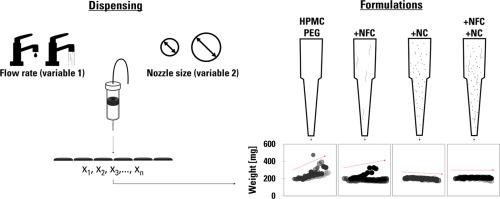The effect of formulation composition and flow conditions on the robustness of semisolid extrusion 3D printing: a case study on poorly water-soluble itraconazole for oral dosage form production
IF 4.7
3区 医学
Q1 PHARMACOLOGY & PHARMACY
引用次数: 0
Abstract
Semisolid extrusion 3D printing is a manufacturing method that has shown promising results in precise production of patient specific dosage forms. Drug nanocrystals, where the particle size of the drug is in the nanometer range, is an attractive formulation strategy for improving the bioavailability of poorly water-soluble drugs. However, because nanocrystals remain suspended in the semisolid extrusion 3D printing formulation, dispensing of the material might be adversely affected by these particles. Currently, the effect of suspended drug nanocrystals on the semisolid extrusion dispensing precision is not well understood. In this study, dispensing precision was evaluated by analysing the weight variation during semisolid extrusion 3D printing. The formulation base, where itraconazole nanocrystals and nanofibrillated cellulose were added, consisted of polyethylene glycol, hydroxypropyl methylcellulose, and water. It was discovered that nanocrystals improved the dispensing precision compared to the nanocrystal free formulation base. Additionally, nanofibrillated cellulose could be combined with nanocrystals to improve the dispensing precision even further. The dispensing precision of the formulations was found to be linked with the viscosity at the high shear rate region. In conclusion, the data suggests that drug nanocrystal containing oral dosage forms can be precisely manufactured using semisolid extrusion 3D printing, without major indication of drug nanocrystals adversely affecting the dispensing process.

配方组成和流动条件对半固态挤出3D打印稳健性的影响:以口服剂型生产的难水溶性伊曲康唑为例
半固态挤压3D打印是一种制造方法,在精确生产患者特定剂型方面显示出有希望的结果。药物纳米晶体,其中药物的粒度在纳米范围内,是一个有吸引力的配方策略,以提高生物利用度的低水溶性药物。然而,由于纳米晶体悬浮在半固态挤压3D打印配方中,这些颗粒可能会对材料的点胶产生不利影响。目前,悬浮剂纳米晶体对半固态挤出点胶精度的影响还不清楚。在本研究中,通过分析半固态挤压3D打印过程中的重量变化来评估点胶精度。配方碱中加入了伊曲康唑纳米晶体和纳米纤化纤维素,由聚乙二醇、羟丙基甲基纤维素和水组成。研究发现,纳米晶体比无纳米晶体配方基提高了点胶精度。此外,纳米纤维化纤维素可以与纳米晶体结合,进一步提高分配精度。发现配方的点胶精度与高剪切速率区域的粘度有关。总之,这些数据表明,含有口服剂型的药物纳米晶体可以使用半固态挤出3D打印技术精确制造,没有药物纳米晶体对配药过程产生不利影响的主要迹象。
本文章由计算机程序翻译,如有差异,请以英文原文为准。
求助全文
约1分钟内获得全文
求助全文
来源期刊
CiteScore
9.60
自引率
2.20%
发文量
248
审稿时长
50 days
期刊介绍:
The journal publishes research articles, review articles and scientific commentaries on all aspects of the pharmaceutical sciences with emphasis on conceptual novelty and scientific quality. The Editors welcome articles in this multidisciplinary field, with a focus on topics relevant for drug discovery and development.
More specifically, the Journal publishes reports on medicinal chemistry, pharmacology, drug absorption and metabolism, pharmacokinetics and pharmacodynamics, pharmaceutical and biomedical analysis, drug delivery (including gene delivery), drug targeting, pharmaceutical technology, pharmaceutical biotechnology and clinical drug evaluation. The journal will typically not give priority to manuscripts focusing primarily on organic synthesis, natural products, adaptation of analytical approaches, or discussions pertaining to drug policy making.
Scientific commentaries and review articles are generally by invitation only or by consent of the Editors. Proceedings of scientific meetings may be published as special issues or supplements to the Journal.

 求助内容:
求助内容: 应助结果提醒方式:
应助结果提醒方式:


